This post is a summary of the talk “Start at the end” given by Hannah Smith at the Green IO Paris conference on 5 Dec 2025. You can download a pdf copy of the slides.
At the end of this post you’ll also find two lists:
- Various places where people are finding positive stories of the future, crowd-sourced from giving the same talk for the RIPE NCC Green Tech Hackathon and then at Green IO Paris. Jump to the positive stories.
- Various activities that adults like to do to play. Jump to the play suggestions.
This is not quite word for word, but should give a good overview of the main points.
Intro.
Being honest this is probably the hardest talk I’ve ever set out to write.
Why? Because I’ve decided to take a bit of a risk and talk about something a bit different for me, but something that I think is at the absolute heart of the challenge ahead of us.
It also happens to be something that I don’t think we’re giving enough space to in this emerging industry of digital sustainability.
Our technical work.
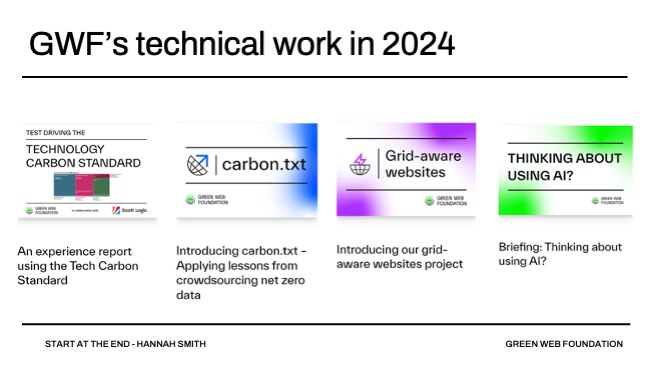

My educational background is technical. I studied computer science at university and I worked as a freelance web developer for many years. I consider myself to have an engineer’s mindset. I love building and fixing stuff.
At Green Web Foundation, I get to work on so many cool and interesting projects with my amazing colleagues. Many of which are deep technical issues. I’m normally found giving technical type talks.
But this isn’t the only hat I wear, or have worn.
My careers and focal points.


I’ve also had a seven year career in business change management at the Environment Agency. There I learned a very different skillset.
My job now is Director of Operations.
The thing I care most about is ensuring myself and my team are able to deliver with impact, and we are able do that in a sustained way. We don’t want to burn out – we’re a small team with mega ambition.
At the heart of helping to make that happen is being an enabler for joyful and effective delivery. You can think of “joyful and effective delivery” as my tagline.
To do this well I think it’s important to have an appreciation of humanity, and what makes us human.
This is a talk about humanity.


So that’s basically what this talk is about – ways I’ve been thinking about humanity in order to help us acheive our mission of a fossil-free internet by 2030.
Am I an expert to be talking about humanity? Probably not. Never studied it, and have no real clue about the arts. Only that I like them.
But I am most certainly a human and have my own lived experiences. I’m also a keen observer.
I’m observing something that worries me.
I’m worried that as a tech industry we seem to be rubbing humanity away for the sake of efficiency. One step, one click at a time. That seems to a key goal of AI.
Is it seeping into our mindset of digital sustainability too?
I can’t help but wonder what is the point of digital sustainability if it doesn’t encompass thinking about the WHY of the tech we’re working to optimise through green coding and other such practices. How is our work supporting our humanity?
I think about this a lot.
We think about this at GWF all the time.
Our end = digital is sustainable?
This is the end part of my talk. The why do we care about digital sustainabilty. What and who are we doing it for?


What really are our goals?
What are the stories that indicate we’re at a good end? Are we hearing enough stories that model a positive outcome?


Do we hear that the end we’re aiming for is:
- Digital exists to regenerate society
- Backwards compatibility forever
- We only need one device for life
- Individuals are empowered to decide how much is “just enough internet“
- Inequality is designed away
This talk is called start at the end. So what’s the starting part? And what are the hacks to encourage this kind of thinking into our work?
One area that I think holds a lot of potential for solutions is around stories. There have been lots of things making me remember that the stories we tell each ourselves, and each other matter.
Our stories matter.
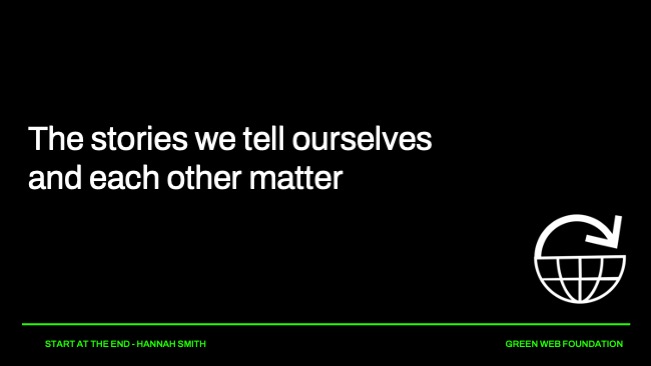

Stories are at the core of our humanity and experience as humans. We’ve been telling stories for 30,000 years plus. Or is it 200,000 years? We don’t really know for sure.
Long before written language emerged, our ancestors relied on oral tradition as their primary means of communication.
This was often multi-faceted communication such as spoken word, songs and dances, poems, rituals, artworks, carvings.
This message about the importance of stories has been coming to me from many different angles.
From my interest in leadership and public speaking. More recently climate change communications experts are also saying the same thing.
You’re not going to change someone’s mind with facts and figures – you’re going to change it by using those measurements as part of a story that speaks to our complex, messy and somewhat unpredictable humanity. Stories that people can see themselves as part of.
A hopeful story about attitude.
Let me move on to telling you a story I like. About a person who I think does represent the kind of humanity I’d like to see more of.
This is Christiana Figueres, a Costa Rican diplomat.
In 2009, six months after a spectacularly failed climate change summit in Copenhagen, Christiana was appointed to lead the next round of international climate change negotiations.
In a press conference following her appointment she was asked if she thought this were possible. She replied “not in my lifetime”.
But, on December 12 2015, here in Paris, 195 governments came together and made an agreement. They decided, unanimously, to intentionally change the course of the global economy in order to protect the earth and improve the quality of life for all of us.
So how did this remarkable achievement happen? What changed?
Christiana realised attitude and belief had to come first.
“Impossible is not a fact, it’s an attitude.” (She’s done a great TED talk on this).
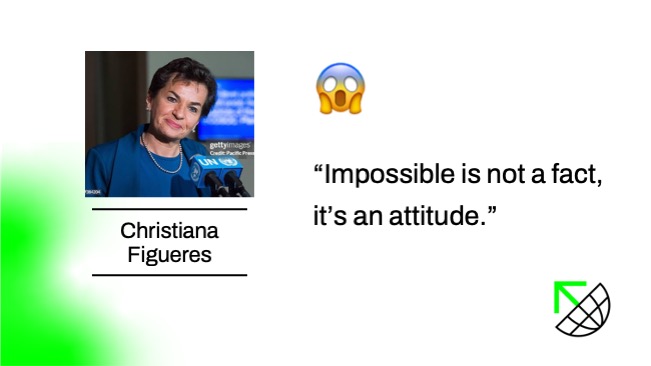

Figueres says “I decided, right then and there, that I was going to change my attitude, and I was going to help the world change its attitude on climate change.”
She knew we had to change the tone of the conversation if she were going to succeed. Different stories were needed. And changing her belief came first.
Where to find good stories?
(Side note: at this end of this post, I summarise a whole bunch of places that people have recommended as places to find good stories. Or at least stories that have reasonated with them. I’ve asking people to tell me each time I’ve done a version of this talk. Quick jump to the end for stories.)
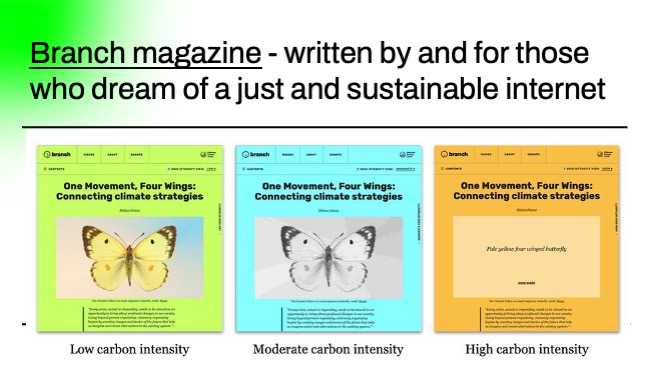

Our Branch magazine project has been running since 2020. It’s written by and for those who dream of a just and sustainable internet.
This is where I first heard the terms solarpunk, speculative futures and digital imaginaries.
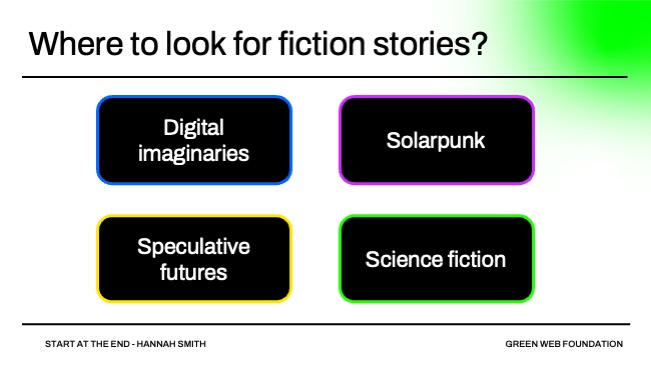

Branch is the first place where I first heard the terms solarpunk, speculative futures and digital imaginaries. Star Trek, a popular science fiction piece, is credited with inspiring all sorts of inventions like the mobile phone.
Stories make beliefs.
Going back to Christiana Figueres. She made something possible through telling a story that helped her form a belief.
Let’s explore beliefs for a bit.
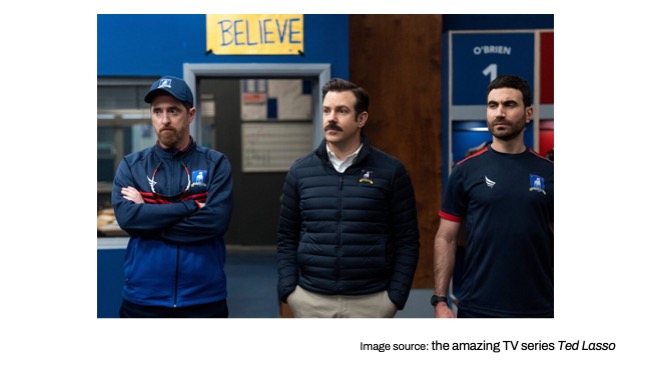

Anyone working with athletes knows the importance of helping an athlete believe in themselves.
The TV show, Ted Lasso, is a fictional exploration into this in the world of football. It’s a comedic, but poignant look at humanity and the importance of beliefs. I highly recommend if you can cope with a bit of swearing.
There’s a lot of science around beliefs. Some things we can explain. Some things science is still trying to understand.
Science is able to show that the mind and body are linked to some degree.
We have stories in our own culture that speak about this “She acted on a gut feeling”. “They died of a broken heart”. “Do you smell trouble, he said”.
Here’s one example that demonstrates how your mind can change your physical body. There were many more I could have put into this talk. But here’s one that I think helps to illustrate what I’m getting at.
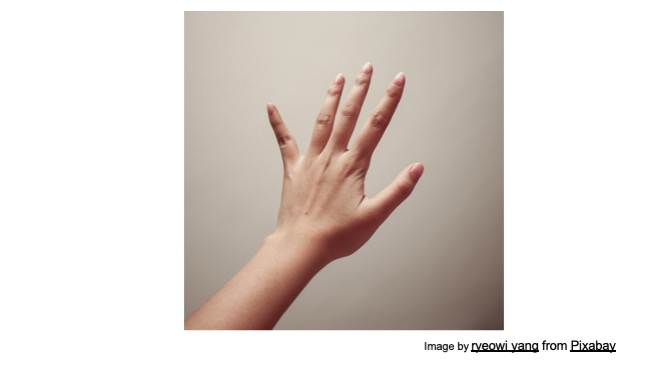

A 1992 study split people into two groups.
Group one exercised a particular finger muscle for five days. After that time the study found those people increased the strength of that muscle by 30% after five days.
Group two were people just imagining exercising that finger. Not moving their finger all, just visualising doing it. Their strength also increased by 22%. I find this quite amazing.
This is one place where our own mind can influence our own body. What about those things that are not our bodies. Can we influence those?
The year of manifest.
The Cambridge Dictionary has named “manifest” their word of 2024.
What is manifesting? Essentially believing that your thoughts are what changes things.
There’s definitely a bit of an issue with the simplicity of this definition. Taken simply manifesting can be represented as this.
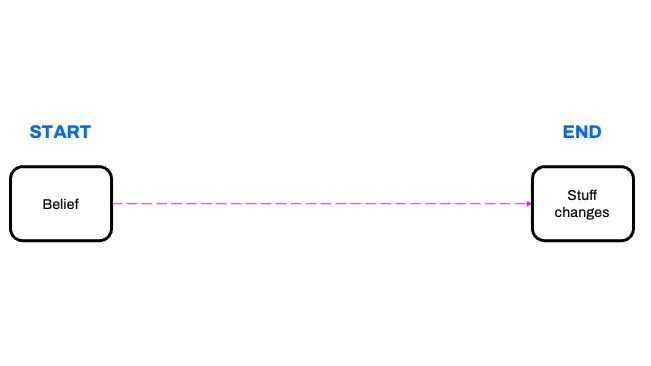

There’s a start and end. But it doesn’t suggest all the stuff that really happens in the middle. There’s a chain of events that gets us from this starting point to the end.
I think it’s more reasonable to think of it like this.
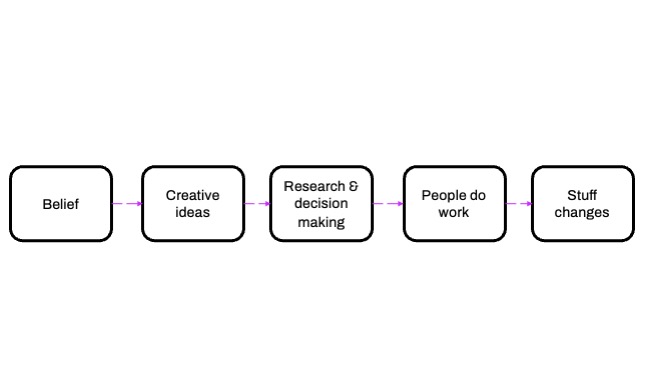

You form a belief. That belief enables you to start seeing creative possibilities to make that change. Once you’re armed with some ideas on how you could move forward you can get into research and decision making. Once you’ve got some decisions, and resources in place people can crack on and do the work. That is what ultimately leads to change.
Of course each step is fraught with risk, and certain conditions are needed to make it possible to complete each step and move to the next.
But you get the idea.
There is work involved not just magic thoughts. But magic thoughts get the ball rolling.
A nice framework of creativity.
This creative practice competency framework from the UN makes it very concrete to understand the different facets of creativity. My engineer brain loved finding this.
This is a very tangible way of thinking about what it involves and what kind of mindset shifts, or attitudes can be helpful.
It’s also one of many places I have seen the term “serious play” come up, which we’ll get to shortly.
Back to our diagram.
But for now, let’s also add the point I started with about Christiana. Stories are where beliefs come from.
Let’s add another box to our diagram.
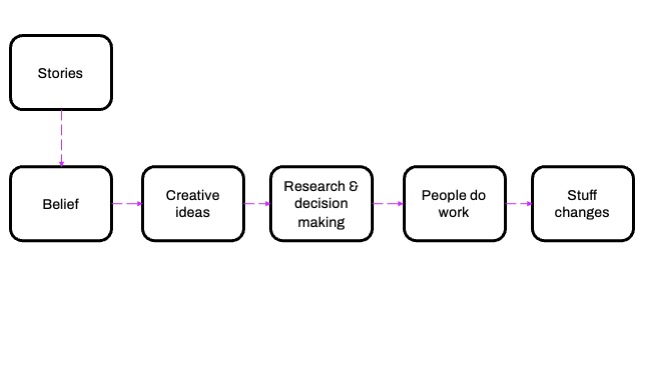

Our first hack for getting more humanity in digital sustainability.
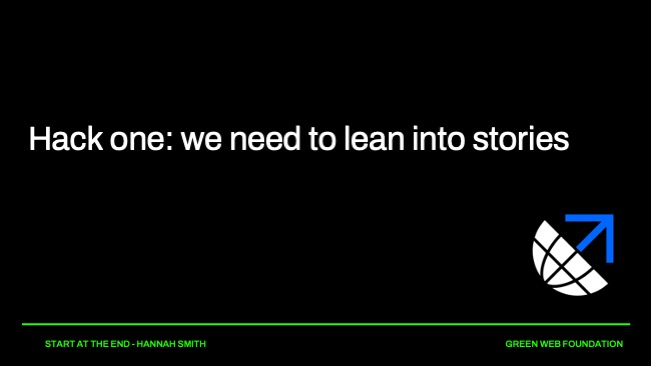

Our first hack – if we’re able to put more time and effort into stories that shape positive outcomes and beliefs for ourselves and others, we can impact the process of change for the better.
Making our own stories.
It’s important that we don’t just lean into the stories coming from big tech. Their stories are not likely to align with the best interest of humanity. They’re more likely to align with the best interests of an elite group of shareholders who want profit.
Why do some people seem naturally better at telling stories than others, than me? This has never been a natural skill for me, I’ve worked at learning it and am still working on it.
I don’t have to think too hard to work backwards from stories to realise that the thing that comes before is imagination.
Learning about imagination.
There are two specific resources that have taught me a lot about imagination and why it matters.
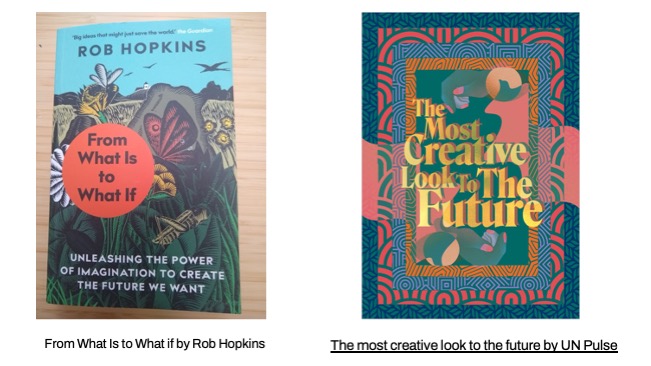

From what is to what if by Rob Hopkins & The most creative look to the future by the UN Pulse team.
Both of these put forward very credible arguments that imagination is the key to unlocking climate change solutions.
But you can’t tell someone just be more imaginative. Hey you, imagine more. Come up with more ideas. No it doesn’t work like that.
There is another hack for cultivating our imagination.
Lucky we have an easy to access sector of society known for imagination. We can learn a lot from them.
Let’s ask the experts in imagination.
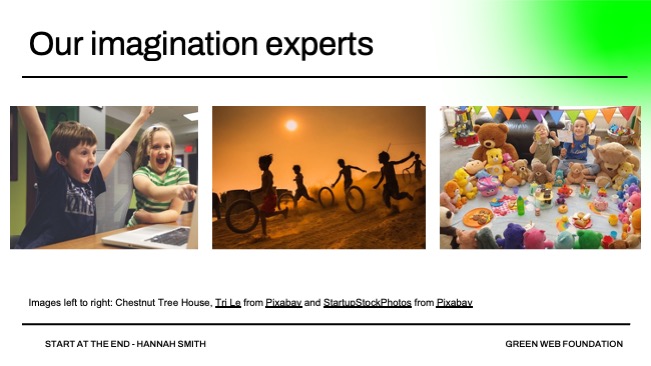

Our experts? Children!
Why are kids so imaginative? It’s because they haven’t yet learned not to be. They come without the inhibitions that seem to block us as adults.
They learn best through play, and we know that giving them time to play is crucial.
Play helps them understand the world around them and develop their skills.
Let’s add play to the diagram.
A satisfying start and end.
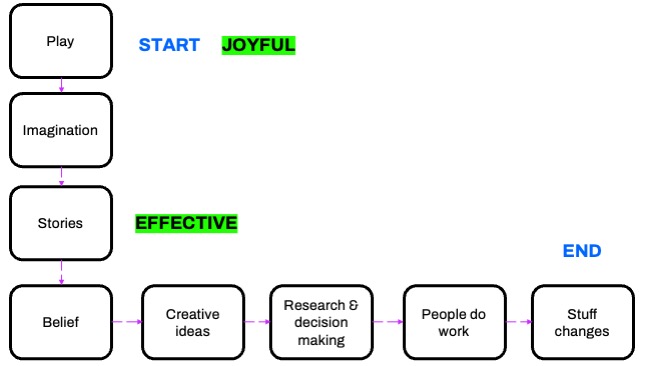

I’m starting to feel more satisfied by the way this process is going. This feels a bit more complete and something I can work with.
To take you back to the start of this talk, I told you that the thing I care about is encouraging joyful and effective delivery.
This feels like a path to get us there.
To the point I’m getting at around play. As adults we tend to favour intelligence and rational thinking above all and put play to one side. As engineers this is a lot of what our training does to us.
This shouldn’t be an either or thing. We need both.
I’d argue it’s a skill like any other that we develop – and that will make us better at what we’re trying to do.
On a personal level, when I do find time to play (and play in a way that works for me at that moment), I always come away feeling good. Sometimes the play is silly, sometimes it’s serious. But either way my mental health benefits too.
There’s tons of research as well that good mental health is a prerequisite for good imagination.
(Side note: also at the end of this post, I summarise a whole load of things that people have shared as things they like to do to play. I didn’t have time to get into that in the talk itself. Quick jump to the end for play.)
Our second hack for getting more humanity in digital sustainability.
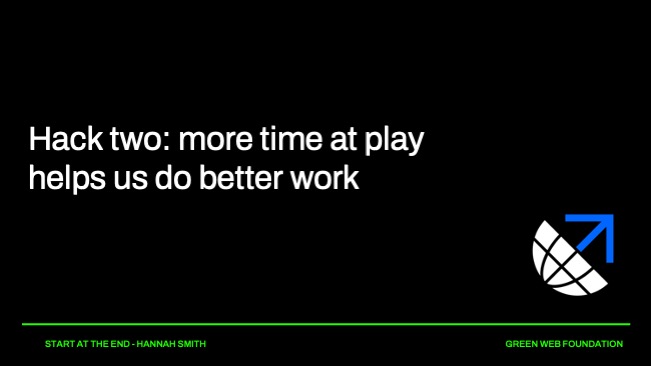

Here’s our second hack for the thing I told you I was worried about at the start of this.
More time at play helps us do better work. We need to make more time to play and nuture our humanity.
Wrapping up.
I heard this quote when I was listening in to a roundtable about the environmental impacts of AI recently.
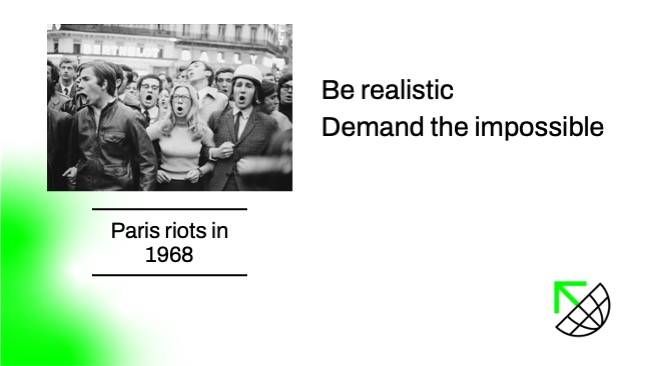

I love this quote. As an aside, was also delighted to realise it has a strong connection to a social revolution in Paris from the 1960s.
It feels apt to wrap up the Green IO conference in Paris with a nod to this.
My impossible demand.
So sod it, based on all this amazing stuff I’m learning, I think I should take my own advice.
I’m going demand something seemingly impossible.
We need to make space for more play in the work we do in the digital sustainability sector.
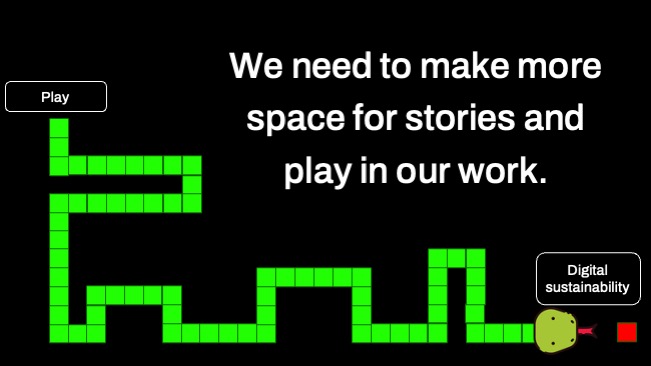

This is how I think we start at the end.
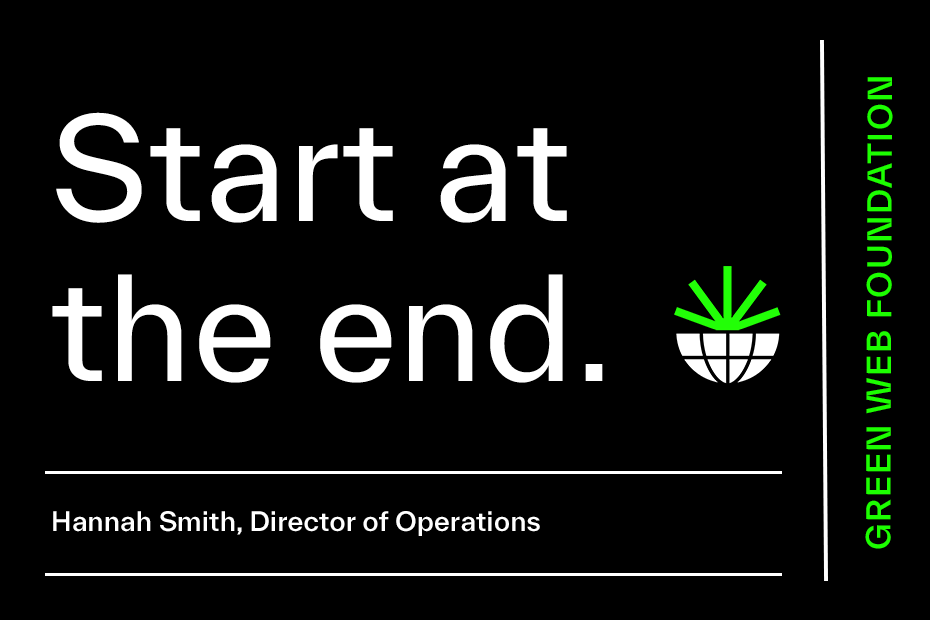

You can download a pdf copy of the slides.
If you found this useful and would like to chat to us about digital sustainability and creating new narratives that serve humanity better, get in touch. We’d love to play with some ideas.
Extra bits
Where people have found good stories.
Thank you to everyone that has helped compile this list by contributing their own places.
Fiction books.
My favourite hopeful story is “The Dispossessed” by Ursula K. LeGuin.
Any Human Power by Manda Scott.
The Ministry for the Future by Kim Stanley Robinson.
Nonfiction books.
Doughnut Economics: Seven Ways to Think Like a 21st-Century Economist, Kate Raworth
Braiding Sweetgrass: Indigenous Wisdom, Scientific Knowledge, and the Teachings of Plants by Potawatomi professor Robin Wall Kimmerer.
Wilding: The return of nature to a British farm by Isabella Tree.
“This changes everything” by Naomi Klein
What If We Get It Right?: Visions of Climate Futures by Ayana Elizabeth Johnson
Books from Philippe Bihouix about low tech such as “L’Âge des low tech: Vers une civilisation techniquement soutenable” (mostly french we think).
Film
Nausicaä of the Valley of the Wind
Other.
Handy research paper about equality, is my go-to for the mix of utopian/dystopian : https://www.sciencedirect.com/science/article/pii/S0921800914000615
The story I am fascinated about > warm data = the information about interrelationships that integrate elements of a complex system Warm Data – The International Bateson Institute – https://batesoninstitute.org/warm-data/
Positive News. https://www.positive.news/
I love the low tech magazine, their server is hosted on solar power and they have done some work to limit how much bandwitdh they send. https://solar.lowtechmagazine.com/ & https://www.solarprotocol.net
This is an amazing compilation of articles and sources about internet cultures which collect our stories online and how we use the digital: https://digitalcontentvalizmakingpublic.net/Stuck-on-the-Platform
“Liminal Excavations”: A zine that explores alternative visions, ideas and critiques on the topic of sustainability and ICT (ICT4S) https://doi.org/10.21428/57a7f7a7.5d685a20
Since 2015: this conference’s publications – https://computingwithinlimits.org
Researchers like Alexandre Monnin (working in french mainly).
The “Nouvelle Empreinte” newsletter
Reinventing Organisations by Frédéric Laloux
Boys Love (BL) 2050 transition narratives (fiction genre)
Ethics by design conference
Every single local activity I discover around me. These are todays stories to be amplified in future 🙂 I’m a stubborn optimist! (This was a comment contributed at Green IO Paris).
Inside myself by learning to travel inward to move outer world by finding truth within, using any internal (meditative) approach that works for you
How adults like to play.
A discussion thread on LinkedIn started by Hannah where people share how they like to play. Feel free to contribute.
Here’s a summary of those things and a few others I’ve heard from people along the way:
- Sports – team sports and individual pursuits
- Lego
- Arts and crafts – knitting, painting, drawing
- Wood working
- Cooking
- Dancing
- Board and computer games
- Mini-games like crosswords and Sudoku
- Puzzles/jigsaws
- Writing
- Dreaming of big plans
- Tinkering with a new coding language/framework
- Time with children and letting them lead the game
- Time with animals
- Serious play games at work
Serious play facilitators
Lucy Hawthorne – https://www.linkedin.com/in/lucyhawthorne/ & https://www.climateplay.org/
If you found this useful and would like to chat to us about digital sustainability and creating new narratives or play opportunities that serve humanity better, get in touch. We’d love to play with some ideas!
